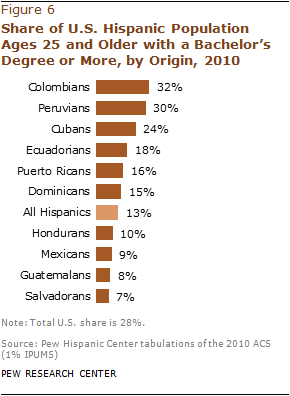Plus, the political transformation has been cataclysmic. Once a red state, California now is completely Democrat run, with a super-majority of Dems in the legislature and no Republicans in other offices.
Latinos poised to catch up with whites in state’s population, Sacramento Bee, July 1, 2013
Perhaps today or certainly sometime very soon, another baby will be born or a new immigrant will arrive and the number of Latinos in California will equal the state’s non-Hispanic white population, according to official state population projections.
The change, to be marked today by a noon event at the state Capitol, has long been predicted by state demographers. It won’t instantly make Latinos an equally powerful political force in California, or bring their incomes into parity with non-Hispanic whites, or close the school achievement gap.
But it is an important milestone – and a reminder that these other goals will become easier to achieve as the number of Latinos continues to grow, several leaders and activists said.
“We are clinging to our culture, our heritage and our language as we assimilate into the American society,” said Orlando Fuentes, president of the Latino Democratic Club, an organizer of today’s event. “We are here because we want the same dream. We want to have part of the pie.”
The term Latino is an ethnic rather than racial designation, according to the Census Bureau. Most Latinos are white, but the bureau draws a distinction between Latinos and non-Hispanic whites.
Fifteen years ago, non-Hispanic whites outnumbered Latinos in California by roughly 5 million, census figures show.
But the Latino population has grown quickly through immigration and comparatively high birth rates. At the same time, the number of whites has fallen as birth rates in that population dropped and more of them left the state than came here.
“We’re adding a substantial number of Latinos through immigration,” said Hans Johnson, senior fellow at the Public Policy Institute of California. “Many of them are young adults ready to start families.”
Today, California has approximately 15 million Latinos and 15 million non-Hispanic whites.
“The Hispanic population will be even with the number of non-Hispanic whites by mid-2013,” state Department of Finance demographers wrote in their most recent series of population projections. “Early in 2014, the Hispanic population will become the plurality in California for the first time since California became a state.”
Even with the rise in numbers, the gap between Latinos and non-Hispanic whites on vital economic and social measures remains at least as big as the population gap was 15 years ago.
In education, for instance, about 40 percent of Latino second-graders scored at or above proficient on end-of-year mathematics tests a decade ago. Last year, 55 percent of Latinos scored at that level, showing a faster rate of improvement than non-Hispanic whites.
But non-Hispanic white second-graders still perform far better as a group on the test: 77 percent scored at or above proficient.
“It’s clear that … Latinos can achieve at high rates,” said Arun Ramanathan, executive director of the Education Trust-West. “But there are often low expectations.”
To continue closing the achievement gap, school leaders must raise expectations for Latinos and intervene quickly with individual students who are having problems, Ramanathan said.
A strong educational background often leads to higher incomes.
In the income area, Latinos, like other ethnic groups, are struggling to shake off the effects of the recession.
The median household income for Latinos in 2011 was about $44,300, down 12 percent from 2000, after adjusting for inflation. By comparison, the median household income for non-Hispanic whites was about $67,000.
Falling Latino incomes can largely be explained by high unemployment and the foreclosure crisis.
The unemployment rate for California Latinos was about three percentage points higher than for non-Hispanic whites in 2012, federal data show. And about 43 percent of California Latinos live in homes they own, compared with about 64 percent of non-Hispanic whites.
“We know that Latinos were more than twice as likely as whites to lose their homes in the course of the Great Recession,” said Paul Leonard, director of the California Office of the Center for Responsible Lending. He cited the ready availability of high-cost, subprime loans for that trend.
Some Latinos relied on their home equity to start or support their businesses. While the housing bust slowed things down, California has about 700,000 Latino-owned businesses, a number that has grown 50 percent in the last decade, said Mark Martinez, president and CEO of the California Hispanic Chamber of Commerce.
“As our population grows, you are going to see more growth in the number of Hispanic-owned businesses,” he said.
Martinez pointed out that the Hispanic population in California is young – the median age is 27, compared with 45 for non-Hispanic whites, census figures show. Young families drive growth, he said, and growth drives entrepreneurship.
By 2064, according to the state Department of Finance, California will have 25 million Latinos and 15.6 million whites.
“Demography is destiny,” said Johnson, of the Public Policy Institute, adding that given the age breakdown of California’s Latinos, “it is pretty certain that these trends will continue into the future.”




 The Sacramento Bee report below is rather optimistic that a majority-Hispanic California won’t be a third-world slum similar to Mexico’s poor regions.
The Sacramento Bee report below is rather optimistic that a majority-Hispanic California won’t be a third-world slum similar to Mexico’s poor regions. 








